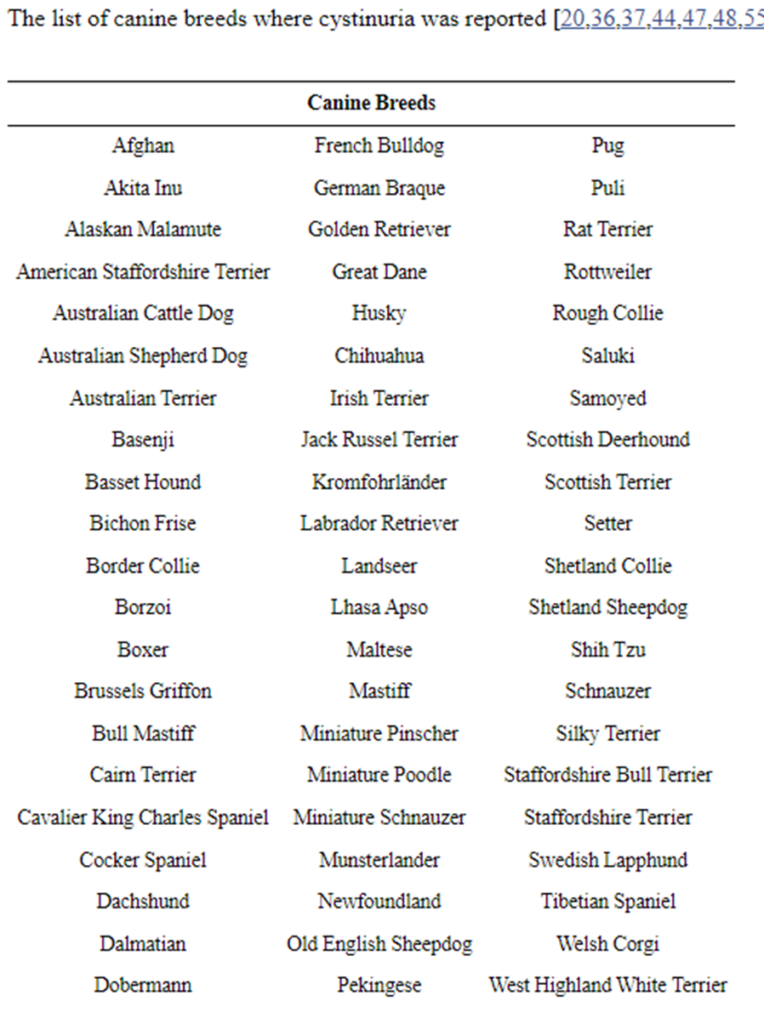Recently a Shikoku in Europe was diagnosed with Cystinuria an inherited metabolic defect that usually effects the lower urinary tract. With the discovery of Cystinuria in the Shikoku, breeders have begun to review breeding records and pedigrees to determine which breeding dogs and bitches need to be tested for this genetic disorder to ensure that this genetic disease is curbed quickly.
In dogs, the presence of cystine uroliths (stones) was reported in 1823 and thus cystinuria was the first reported canine inborn error of metabolism. Now, cystinuria is a disease with worldwide distribution and it is known to affect more than 170 canine breeds according to the reports of veterinary urolith analysis laboratories. The prevalence of cystine urolithiasis is much higher in European countries (up to 14% according to the recent reports) when compared to North America (United States and Canada) where it is approximately 1–3%.
Cystinuric dogs may form uroliths mostly in lower urinary tract which are associated with typical clinical symptoms such as difficulty with urination. The management of cystinuria is aimed at urolith removal or dissolution which may be reached by dietary changes or medical treatment. In dogs with androgen-dependent cystinuria, castration will help.

In dogs, cystinuria had been historically divided into two types: type I referring to a mutation in a SLC3A1 gene with autosomal recessive inheritance and non-type I cystinuria which is associated with milder degree of cystinuria and which is observed in mature intact males of various breeds. The new classification system describes type I cystinuria with autosomal recessive inheritance, type II with autosomal dominant inheritance, and type III for sex-limited inheritance where the disease only occurs in older intact males. Involvement of the SLC3A1 gene is indicated by adding A, and similarly B indicates mutations in SLC7A9. Autosomal recessive inheritance can only occur when both the bitch and the dog used for the breeding carry the recessive gene. Autosomal dominant inheritance occurs when one parent carries the gene which in this case is not a recessive gene but rather a dominate one.

Treatment and Prevention
Cystinuria per se, as an inborn error of metabolism, cannot be successfully treated. The management of cystinuria is aimed at urolith removal or dissolution in case of urolithiasis and/or prevention of urolith formation. After surgical removal, cystine uroliths commonly recur within 6–12 months. Because of the high recurrence rate, prevention is necessary.
Dietary treatment plays a crucial role in the management of cystine stone formation. The dissolution can be achieved by decreasing the concentration of crystallogenic compounds and by increasing cystine solubility.
Urine dilution is an essential step for the prevention and/or dissolution of uroliths regardless of their mineral type. Increased diuresis (increased production of urine) decreases the concentration of crystal precursors and stimulates more frequent urination, decreasing the time for crystal aggregation. Increasing dietary moisture significantly reduces urinary specific gravity and it is an effective way to enhance diuresis.
High-protein foods should be avoided in dogs at risk of cystine urolithiasis. Consumption of low protein, moist veterinary food led to a 20–25% reduction in 24-h urine cystine excretion in cystinuric dogs when compared to moist, canine adult maintenance food. Urine cystine excretion can be modulated by dietary protein intake, and more specifically methionine (precursor of cysteine) and cysteine. Feeding a diet containing amounts of these essential amino acids close to their minimum is therefore recommended. Most plant protein sources have smaller amounts of sulfur amino acids than animal proteins. Protein levels in foods for cystinuric dogs should be between 10% and 18% dry matter. Because of possible taurine and carnitine deficiency, cystinuric dogs should be monitored or their diets should be supplemented with carnitine and taurine.
Dietary sodium restriction seems to be an important component of the therapeutic strategy in cystinuric people because dietary sodium may enhance cystinuria. Dietary sodium in canine therapeutic diets should be limited to less than 0.3% dry matter.
As mentioned above, the solubility of cystine in urine is pH dependent. Beneficial effect has been reported in feeding alkalinizing food. Thus, the food that produces a urinary pH range of 7.1–7.7 is recommended for dogs with cystine urolithiasis. Urinary pH values higher than 7.7 should be avoided until it is determined whether they provide a significant risk factor for formation of calcium phosphate uroliths. When a therapeutic diet alone is not able to provide alkaline urine, the administration of alkalinizing agents is recommended. Because of the reports that dietary sodium may enhance cystinuria, potassium citrate should be preferred to sodium bicarbonate. Desired goals of dietary management are urine pH values above 7.5 and urine specific gravity below 1.020.
Surgical or medical castration can resolve cystinuria in the subset of male dogs with androgen-dependent cystinuria. Castration appears to lower the urinary cystine and COLA concentrations and to prevent cystine calculi formation. The effect of castration in breeds with type III of cystinuria seems to have greater effect in comparison with dietary changes.

Follow this link for more complete information

Jno
February 4, 2022 at 07:19
The genetic discussion is very interesting for me. Thanks for such a deep understanding of canine genetics and the application of your knowledge to improve the Shikoku breeds. Your work is truly exceptional in the dog breeding world.
admin
February 4, 2022 at 09:44
Happy that this info was of interest. Hopefully we can track down the carriers of the gene as we still have an opportunity to ensure that Cystinuria will not be a health issue in the future.